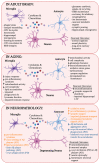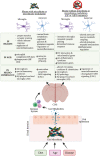Modulation of Glial Function in Health, Aging, and Neurodegenerative Disease
- PMID: 34531726
- PMCID: PMC8439422
- DOI: 10.3389/fncel.2021.718324
Modulation of Glial Function in Health, Aging, and Neurodegenerative Disease
Abstract
In the central nervous system (CNS), glial cells, such as microglia and astrocytes, are normally associated with support roles including contributions to energy metabolism, synaptic plasticity, and ion homeostasis. In addition to providing support for neurons, microglia and astrocytes function as the resident immune cells in the brain. The glial function is impacted by multiple aspects including aging and local CNS changes caused by neurodegeneration. During aging, microglia and astrocytes display alterations in their homeostatic functions. For example, aged microglia and astrocytes exhibit impairments in the lysosome and mitochondrial function as well as in their regulation of synaptic plasticity. Recent evidence suggests that glia can also alter the pathology associated with many neurodegenerative disorders including Alzheimer's disease (AD) and Parkinson's disease (PD). Shifts in the microbiome can impact glial function as well. Disruptions in the microbiome can lead to aberrant microglial and astrocytic reactivity, which can contribute to an exacerbation of disease and neuronal dysfunction. In this review, we will discuss the normal physiological functions of microglia and astrocytes, summarize novel findings highlighting the role of glia in aging and neurodegenerative diseases, and examine the contribution of microglia and astrocytes to disease progression.
Keywords: Alzheimer’s disease; Parkinson’s disease; aging; astrocytes; glia; microbiome; microglia; neurodegeneration.
Copyright © 2021 Hanslik, Marino and Ulland.
Conflict of interest statement
The authors declare that the research was conducted in the absence of any commercial or financial relationships that could be construed as a potential conflict of interest.
Figures


References
-
- Aloisi F. (1999). “The Role of Microglia and Astrocytes in Cns Immune Surveillance and Immunopathology,” in The Functional Roles of Glial Cells in Health and Disease Advances in Experimental Medicine and Biology, eds Matsas R., Tsacopoulos M. (Boston, MA: Springer US; ), 123–133. - PubMed
Grants and funding
LinkOut - more resources
Full Text Sources

